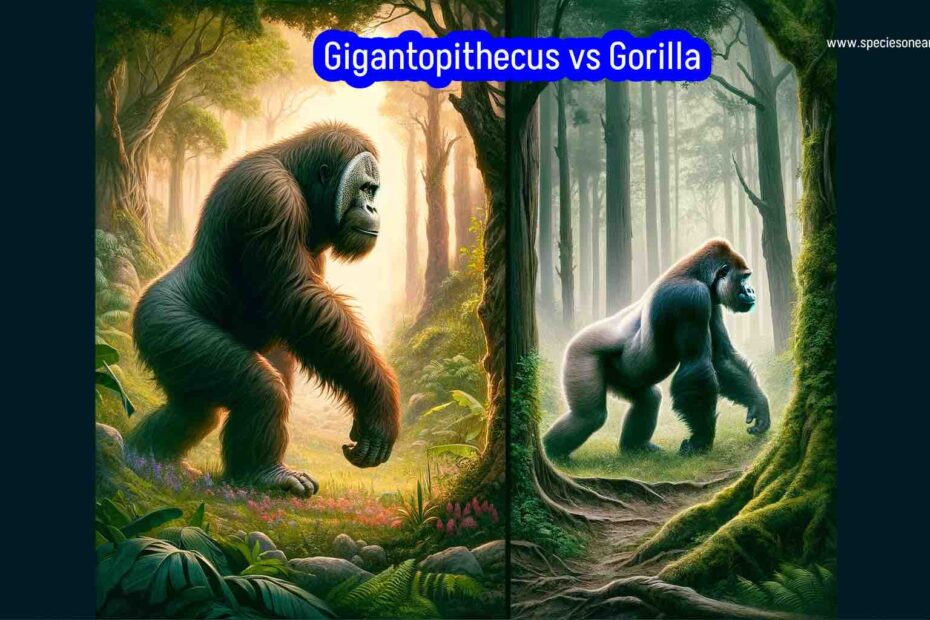When it comes to discussing primates of colossal stature and intriguing characteristics, the comparison between Gigantopithecus and gorillas often comes up. Although they share a basic familial resemblance, being great apes, there are numerous differences that set these two apart. Let’s explore the top 10 differences between Gigantopithecus and gorillas that help paint a clearer picture of these fascinating creatures.
1. Size: The Most Obvious Difference
Gigantopithecus: The sheer size of Gigantopithecus is the most striking difference. Estimates suggest they stood up to 10 feet tall and weighed around 1,100 pounds.
Gorilla: In contrast, the largest gorillas, the Eastern lowland gorillas, stand up to 5.6 feet tall and weigh around 450 pounds.
2. Existence: A Timeline Apart
Gigantopithecus: These giants roamed the earth during the Pleistocene epoch, from about 2 million to 11,000 years ago.
Gorilla: Gorillas, on the other hand, have been around for about 9 million years and are very much a part of our current ecosystem.
3. Habitat: Where They Called Home
Gigantopithecus: They are believed to have lived in the forests of what is now China, India, and Vietnam.
Gorilla: Modern gorillas inhabit the tropical and subtropical forests of Sub-Saharan Africa.
4. Diet: What They Ate
Gigantopithecus: Their diet likely consisted of bamboo, fruits, and other forest vegetation.
Gorilla: Gorillas primarily eat leaves, stems, and fruits, occasionally supplementing their diet with small insects.
5. Social Structure: Lone Giant vs Social Animal
Gigantopithecus: Little is known about their social structure, but they may have been solitary, given their size and dietary needs.
Gorilla: Gorillas live in groups led by a dominant male, exhibiting complex social interactions.
6. Locomotion: How They Moved
Gigantopithecus: The exact mode of locomotion is unknown, but they might have been bipedal due to their size.
Gorilla: Gorillas primarily move quadrupedally, using their knuckles to support their weight.
7. Dental Structure: Insights from Teeth
Gigantopithecus: Their large, flat teeth suggest a diet heavy on tough, fibrous materials.
Gorilla: Gorillas have large canines and flat molars, suitable for their varied vegetarian diet.
8. Tool Use and Cognitive Abilities
Gigantopithecus: There is no evidence to suggest Gigantopithecus used tools or had advanced cognitive abilities.
Gorilla: Gorillas have demonstrated the use of tools and possess significant cognitive skills, including communication abilities.
9. Fossil Record: What Remains Tell Us
Gigantopithecus: The fossil record is sparse, mostly limited to teeth and jawbones.
Gorilla: There is a richer fossil and contemporary record for gorillas, offering more comprehensive insights into their evolution and behavior.
10. Cultural Impact: Myth vs Reality
Gigantopithecus: Gigantopithecus has a mythical status, often inspiring tales and speculations.
Gorilla: Gorillas, while also subjects of fascination, are studied more in the realm of real-world conservation and biology.
The comparison of Gigantopithecus vs gorilla provides a fascinating glimpse into the world of primates, both past and present. While Gigantopithecus remains shrouded in mystery due to its ancient existence and limited fossil record, gorillas offer a window into the complex social structures and behaviors of great apes. Understanding these differences not only enriches our knowledge of primate evolution but also highlights the diversity and adaptability of life on Earth.
